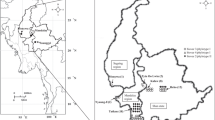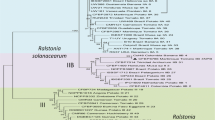Abstract
Acidovorax avenae causes red stripe disease, which is characterised by red stripe and top rot symptoms in sugarcane (Saccharum spp. hybrids). The incidence of one or both these symptoms in the sugarcane fields was up to 30% in the Chiapas and Veracruz states of Mexico between 2015 and 2016. This study aimed to identify the causative agent of these symptoms and to determine the distribution and incidence of the disease in sugarcane-producing agroecological regions. Eleven bacterial isolates with phenotypic characteristics similar to those of A. avenae were isolated from the symptomatic tissue. Phylogenetic reconstruction based on the 16S rDNA sequence identified these 11 isolates as A. avenae with 99% identity. A. avenae infection was identified in three of the seven agroecological regions of Mexico (Cordoba-Gulf, Papaloapan-Gulf, and Southern region) with incidences ranging between 1 and 55%. The highest incidence of A. avenae infection was in the COLMEX 94-8 variety in the Cordoba-Gulf region (55%), whereas the lowest (1%) incidence was in the CP 72-2086 variety in the Papaloapan-Gulf region. The inoculation of these 11 strains resulted in the development of necrosis and wilting of the youngest leaves, dead of inoculated leave, and stem rot symptoms in the susceptible variety CP 72-2086. This is the first study to report the distribution and incidence of A. avenae in sugarcane plantations of Mexico.


Similar content being viewed by others
References
Bipen, K., Y. Rakesh, and K. Ratinderbir. 2014. Present status of bacterial top rot disease of sugarcane in Indian Punjab. Plant Disease Research 29: 68–70.
Che, F., M. Iwano, N. Tanaka, S. Takayama, E. Minami, N. Shibuya, S. Takayama, E. Minami, N. Shibuya, I. Kadota, and A. Isogai. 1999. Biochemical and morphological features of rice cell death induced by Pseudomonas avenae. Plant and Cell Physiology 40: 1036–1045. https://doi.org/10.1093/oxfordjournals.pcp.a029485.
Chu, N., J.R. Zhou, H.Y. Fu, M.T. Huang, H.L. Zhang, and S.J. Gao. 2020. Global gene responses of resistant and susceptible sugarcane cultivars to Acidovorax avenae subsp. avenae identified using comparative transcriptome analysis. Microorganisms 8: 10. https://doi.org/10.3390/microorganisms8010010.
CONADESUCA. 2018. Comité Nacional para el Desarrollo Sustentable de la Caña de Azúcar (https://www.gob.mx/Conadesuca), México. Accessed 15 Oct 2018.
Doyle, J.J., and J.L. Doyle. 1990. Isolation of plant DNA from fresh tissue. Focus 12: 13–15.
Fontana, P.D., C.A. Fontana, D. Bassi, E. Puglisi, S.M. Salazar, G.M. Vignolo, and P.S. Coccocelli. 2016. Genome sequence of Acidovorax avenae strain T10_61 associated with sugarcane red stripe in Argentina. Genome Announcements 4: e01669-e1715. https://doi.org/10.1128/genomeA.01669-15.
Fontana, P.D., A.M. Rago, C.A. Fontana, G.M. Vignolo, P.S. Cocconcelli, and J.A. Mariotti. 2013. Isolation and genetic characterization of Acidovorax avenae from red stripe infected sugarcane in Northwestern Argentina. European Journal of Plant Pathology 137: 525–534. https://doi.org/10.1007/s10658-013-0263-y.
Fontana, P.D., N. Tomasini, C.A. Fontana, V. Di Pauli, P.S. Cocconcelli, G.M. Vignolo, and S.M. Salazar. 2019. MLST reveals a separate and novel clonal group for Acidovorax avenae strains causing red stripe in sugarcane from Argentina. Phytopathology 109: 358–365. https://doi.org/10.1094/PHYTO-08-18-0303-R.
Giglioti, E.A., and S. Matsuoka. 2000. False red stripe. In A guide to sugarcane diseases, ed. P. Rott, R.A. Bailey, J.C. Comstock, and B.J. Croft, 27–31. Montpellier: Cirad Publications Service.
Giordano, P.R., J.M. Vargas Jr., A.R. Detweiler, N.M. Dykema, and L. Yan. 2010. First report of a bacterial disease on creeping bentgrass (Agrostis stolonifera) caused by Acidovorax spp. in the United States. Plant Disease 94: 922. https://doi.org/10.1094/PDIS-94-7-0922B.
Giordano, P.R., A.M. Chaves, N.A. Mitkowski, and J.M. Vargas Jr. 2012. Identification, characterization, and distribution of Acidovorax avenae subsp. avenae associated with creeping bentgrass etiolation and decline. Plant Disease 96: 1736–1742. https://doi.org/10.1094/PDIS-04-12-0377-RE.
Grisham, M.P., and R.M. Johnson. 2014. Red stripe caused by Acidovorax avenae subsp. avenae in Louisiana sugarcane. Phytopathology 104 (Suppl. 3): 472.
Hall, T. A. 1999. BioEdit: a user-friendly biological sequence alignment editor and analysis program for Windows 95/98/NT. In: Nucleic acids symposium series, vol. 41, no. 41, 95–98. London: Information Retrieval Ltd., c1979-c2000.
Hu, F.P., J.M. Young, C.M. Triggs, D.C. Park, and D.J. Saul. 2001. Relationships within the proteobacteria of plant pathogenic Acidovorax species and subspecies, Burkholderia species, and Herbaspirillum rubrisubalbicans by sequence analysis of 16S rDNA, numerical analysis and determinative tests. Antonie van Leeuwenhoek 80: 201–213. https://doi.org/10.1023/A:1013066912814.
Ji, C., J. Ou, D. Xu, and R. Pan. 2014. First report of corn bacterial leaf stripe caused by Acidovorax avenae in Guangdong Province, China. Plant Disease 98: 1424. https://doi.org/10.1094/PDIS-03-14-0334-PDN.
Koike, H. 1965. The aluminum-cap method for testing sugarcane varieties against leaf scald disease. Phytopathology 55: 317–319.
Kumar, S., G. Stecher, M. Li, C. Knyaz, and K. Tamura. 2018. Mega X: Molecular evolutionary genetics analysis across computing platforms. Molecular Biology and Evolution 35: 1547–1549. https://doi.org/10.1093/molbev/msy096.
Lee, I.M., I.M. Bartoszyk, D.E. Gundersen-Rindal, and R.E. Davis. 1997. Phylogeny and classification of bacteria in the genera Clavibacter and Rathayibacter on the basis of 16S rRNA gene sequence analyses. Applied Environmental Microbiology 63: 2631–2636.
Li, B., L. Wang, M. Ibrahim, M. Ge, Y. Wang, S. Mannan, M. Asif, and G. Sun. 2015. Membrane protein profiling of Acidovorax avenae subsp. avenae under various growth conditions. Archives Microbiology 197: 673–682. https://doi.org/10.1007/s00203-015-1100-9.
Liu, H., W.X. Tian, M. Ibrahim, B. Li, G.Q. Zhang, B. Zhu, and G.L. Xie. 2012. Characterization of pilP, a gene required for twitching motility, pathogenicity, and biofilm formation of Acidovorax avenae subsp. avenae RS-1. European Journal of Plant Pathology 134: 551–560. https://doi.org/10.1007/s10658-012-0038-x.
Martin, J.P., C.A. Wismer, and C.C. Ryan. 1989. Red stripe. In Diseases of sugarcane, ed. C. Ricaud, B.T. Egan, A.G. Gillaspie Jr., and C.G. Hughes, 81–95. Montpellier: Cirad Publications Service.
Mehnaz, S. 2013. Microbes–friends and foes of sugarcane. Journal of Basic Microbiology 53: 954–971. https://doi.org/10.1002/jobm.201200299.
Monteil, C.L., R. Cai, H. Liu, M.E. Mechan Llontop, S. Leman, D.J. Studholme, C.E. Morris, and B.A. Vinatzer. 2013. Nonagricultural reservoirs contribute to emergence and evolution of Pseudomonas syringae crop pathogens. New Phytologist 199: 800–811. https://doi.org/10.1111/nph.12316.
Moore, E.R., A.S. Krüger, L. Hauben, S.E. Seal, R. De Baere, R. De Wachter, R. De Wachter, K.N. Timmis, and J. Swings. 1997. 16S rRNA gene sequence analyses and inter-and intrageneric relationships of Xanthomonas species and Stenotrophomonas maltophilia. FEMS Microbiology Letters 15: 145–153. https://doi.org/10.1111/j.1574-6968.1997.tb12563.x.
Myung, I.S., J.K. Choi, J.M. Wu, J.Y. Lee, H.L. Yoo, and H.S. Shim. 2012. Bacterial stripe of hog millet caused by Acidovorax avenae subsp. avenae, a new disease in Korea. Plant Disease 96: 1222. https://doi.org/10.1094/PDIS-03-12-0320-PDN.
Osada, K.S., L. Fucikovsky, and A. Galindo. 1978. Study of the red stripe disease of sugar-cane. Agrociencia 34: 17–29.
Quisehuatl-Tepexicuapan, E., R. Ferrera-Cerrato, H.V. Silva-Rojas, S. Rodriguez-Zaragoza, A. Alarcón, and J.J. Almaraz-Suárez. 2016. Free-living culturable bacteria and protozoa from the rhizoplanes of three floating aquatic plant species. Plant Biosystems 150: 855–865. https://doi.org/10.1080/11263504.2014.989282.
Rahesh, Y., K. Bipen, and M.S. Devi. 2014. Pathogenic variability among different isolates of the red stripe/top rot causing pathogen in Punjab state. Environment and Ecology 32: 873–877.
Rakesh, Y., and K. Bipen. 2015. Status of Red stripe disease of sugarcane in Punjab, India. Journal of Mycopathological Research 53: 271–274.
Ronquist, F., M. Teslenko, P. Van Der Mark, D.L. Ayres, A. Darling, S. Höhna, B. Larget, L. Liu, M.A. Suchard, and J.P. Huelsenbeck. 2012. MrBayes 3.2: efficient Bayesian phylogenetic inference and model choice across a large model space. Systematic Biology 61: 539–542. https://doi.org/10.1093/sysbio/sys029.
Rott, P., and M.J. Davis. 2000. Red stripe (Top rot). In A guide to sugarcane diseases, ed. P. Rott, R.A. Bailey, J.C. Comstock, and B.J. Croft, 60–62. Montpellier: Cirad Publications Service.
Schaad, N.W., E. Postnikova, A. Sechler, L.E. Claflin, A.K. Vidaver, J.B. Jones, I. Agarkova, A. Ignatov, E. Dickstein, and B.A. Ramundo. 2008. Reclassification of subspecies of Acidovorax avenae as A. avenae (Manns 1905) emend., A. cattleyae (Pavarino, 1911) comb. nov., A. citrulli Schaad et al., 1978) comb. nov., and proposal of A. oryzae sp. nov. Systtematic and Applied Microbiology 31: 434–446. https://doi.org/10.1016/j.syapm.2008.09.003.
Seijo, T.E., and N.A. Peres. 2011. First report of Acidovorax avenae subsp. avenae causing bacterial leaf stripe of Strelitzia nicolai. Plant Disease 95: 1474. https://doi.org/10.1094/PDIS-03-11-0160.
Sentíes-Herrera, H.E., F.C. Gómez-Merino, A. Valdez-Balero, H.V. Silva-Rojas, and L.I. Trejo-Téllez. 2014. The agro-Industrial sugarcane system in Mexico: current status, challenges and opportunities. The Journal of Agriculture Science 6: 26. https://doi.org/10.5539/jas.v6n4p26.
Shan, H., W. Li, Y. Huang, X. Wang, R. Zhang, Z. Luo, and J. Yin. 2017. First detection of sugarcane red stripe caused by Acidovorax avenae subsp. avenae in Yuanjiang, Yunnan, China. Tropical Plant Pathology 42: 137–141. https://doi.org/10.1007/s40858-017-0132-x.
Silva-Rojas, H.V., A. Rebollar-Alviter, A. Valdez-Balero, J.R. Sánchez-Pale, and M.L. Osnaya-González. 2017. Herbaspirillum rubrisubalbicans causing important emergent diseases in sugarcane in Mexico. Phytopathology 107: 19.
Stukenbrock, E.H., and B.A. McDonald. 2008. The origins of plant pathogens in agro-ecosystems. Annual Review of Phytopathology 46: 75–100. https://doi.org/10.1146/annurev.phyto.010708.154114.
Tayeb, L.A., M. Lefevre, V. Passet, L. Diancourt, S. Brisse, and P.A. Grimont. 2008. Comparative phylogenies of Burkholderia, Ralstonia, Comamonas, Brevundimonas and related organisms derived from rpoB, gyrB and rrs gene sequences. Research in Microbiology 159: 169–177. https://doi.org/10.1016/j.resmic.2007.12.005.
Xie, G.L., G.Q. Zhang, H. Liu, M.M. Lou, W.X. Tian, B. Li, X.P. Zhou, B. Zhu, and G.L. Jin. 2011. Genome sequence of the rice-pathogenic bacterium Acidovorax avenae subsp. avenae RS-1. Journal of Bacteriology 193: 5013–5014. https://doi.org/10.1128/JB.05594-11.
Yonzone, R., and M.S. Devi. 2018. Red stripe/top rot disease of sugarcane: a review. International Journal of Current Microbiology and Applied Sciences 7: 1469–1478. https://doi.org/10.20546/ijcmas.2018.701.179.
Zhang, R.Y., B. Zou, Y.W. Yan, C.O. Jeon, M. Li, M. Cai, and Z.X. Quan. 2020. Design of targeted primers based on 16S rRNA sequences in meta-transcriptomic datasets and identification of a novel taxonomic group in the Asgard archaea. BMC Microbiology 20: 25. https://doi.org/10.1186/s12866-020-1707-0.
Acknowledgements
The authors thank the SAGARPA-CONACYT Sectorial Fund for the funding received for this research through the project ‘Diagnosis and comprehensive management of the bacterial syndrome associated with Xanthomonas spp. and of emerging diseases of sugarcane (Saccharum officinarum) in Mexico (Code 2013-02-230876)’ as well as the Biotechnology and Seed Pathology laboratory of the Postgraduate College, Campus Montecillo, (external project PS 15-1063) for partially funding this research.
Author information
Authors and Affiliations
Contributions
CHJ conducted the experiments, collected the data, and wrote a Doctorate dissertation based on this investigation. SAO conceptualised, designed, and conducted the investigation, as well as reviewed and edited the original manuscript draft. HVSR conceptualised and conducted the investigation, provided inputs for phylogenetic analysis, and partially sponsored the project. EHJ performed statistical analyses. MOG, GVP, GNM, and CDLGA conducted the investigation and edited the manuscript. All authors have read and approved the final manuscript.
Corresponding author
Ethics declarations
Conflict of Interest
The authors declare that they have no conflict of interest.
Additional information
Publisher's Note
Springer Nature remains neutral with regard to jurisdictional claims in published maps and institutional affiliations.
Rights and permissions
About this article
Cite this article
Hernández-Juárez, C., Silva-Rojas, H.V., De León García de Alba, C. et al. Molecular Identification, Incidence, and Distribution of Acidovorax avenae in the Sugarcane-Producing Agroecological Regions of Mexico. Sugar Tech 23, 891–899 (2021). https://doi.org/10.1007/s12355-021-00964-w
Received:
Accepted:
Published:
Issue Date:
DOI: https://doi.org/10.1007/s12355-021-00964-w




